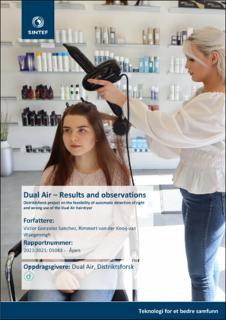| dc.description.abstract | This report summarizes a pre-project funded by Distriktforsk. The purpose of the project was to explore opportunities for developing a smart Dual Air blow-dryer that provides real-time automated feedback to hairdressers using sensors. In July and August 2021, Dual Air and SINTEF conducted a study on hairdressers in Trondheim, Bergen, Oslo, and Sandnes using the Dual Air blow-dryer. Sensor and video data were collected from 20 hairdressers at their workplaces, together with a written description of hairdressing techniques and the use of the Dual Air. Sensors used for data collection were seven wireless tri-axial accelerometers on the bodies of the hairdressers and two Inertial Measurement Units (IMUs, including a tri-axial accelerometer and a tri-axial gyroscope) on the hairdryer. We also captured video of the blow-drying operations. Results from this study show that it is feasible to automatically identify the right and wrong use of Dual Air by using IMU sensors and a trained machine learning model (Long-short term memory neural network - LSTM). However, a larger dataset including a variety of techniques and instances of improper use will help to improve the performance of the chosen LSTM model. We used video for a movement and posture analysis, comparing blow-drying operations using Dual Air and a conventional blow-dryer. Our results show that the Dual Air hairdryer allows hairdressers to perform similar blow-drying operations with a lower shoulder abduction angle and arm position than conventional hair dryers. A larger study is required to estimate the exact difference. Finally, we demonstrated the feasibility of a data collection protocol with hairdressers and have built a comprehensive dataset and analysis framework for further testing and model development as a starting point for a more robust product-ready usage-prediction tool. | en_US |
